designed by Peter JAKAB in December, 1999
improved in Jan. 2001
NOTE for beginners: PICs are general purpose microcontrollers which have to be programmed before you can use them in the actual circuit! Check out this link to learn more.
If you are looking for walkie-talkie or RF circuits, please check here (this page has nothing to do with walkie-talkie circuits).
| I finally got some small 433MHz
radio transmitters and receivers and I needed an encoder/decoder
circuit to make use of them for controlling equipment
remotely. One could realize this by using Motorola MC145026-8
integrated circuits as well, but they need space and a
few external components that must be calibrated by the
user. Not to mention the challenge of creating an encoder/decoder
by myself in software. The encoder/decoder parts are to be connected to a transmitter/receiver module which takes care of the transmission of digital signals by radio or infra waves. The communication signal format is designed to be used for radio transmission (it has a constant 50% signal/silence ratio), but it can work with infrared devices as well. The transmitter has a varying number of buttons and sends the states of these inputs to the receiver. The receiver device decodes the message and sets the outputs accordingly. There are two protocols in the sources: the older version V2 represents digital 0 and 1 as different frequency pulses (800 and 1600 Hz), while the newer V4.0 outputs standard Manchester code (400/800 Hz). I recommend using the Manchester versions as the max. generated frequency is lower and the reception is more stable even with low speed or timing-inaccurate transmission channels. As the source is available, you can combine the various parts of code toghether to design a system that fits your needs. Please note that all the devices have a device ID, which has to be the same between a transmitter and a receiver! This is not the PIC ID stored in a separate area of PIC but a software ID stored in the program area. It is encoded in every transmitted packet and checked to match by the receiver to identify matching transmitters & receivers. |
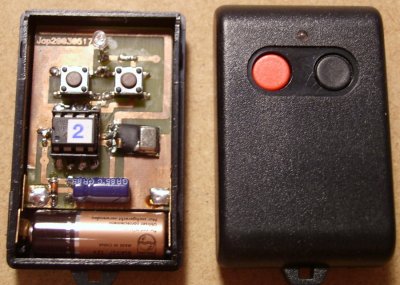 RF transmitters with the PIC encoder |
All the files are provided here without any warranty. Please verify operation first by compiling the sources for flash parts. The sources you see here are proven working in several devices, still if you would find an error, please notify me!
There are two different methods for encoding/decoding channel information:
This version, when powered on, continously transmits the states of all inputs. I recommend installing an ON/OFF switch for the mtx-014 transmitter. The receiver will decode the messages and adapt the output states accordingly. The "TV" TTL output shows that the transmitter is turned ON and signal reception is good. When the signal is absent for about a second, all outputs will go low and the TV out will be cleared. Files are mtx-014 and mrx-009. The transmitter has an ADJUST mode which outputs a periodic signal to calibrate the transmission channel on an oscilloscope. To enter this mode, press TC2 while turning the power on.

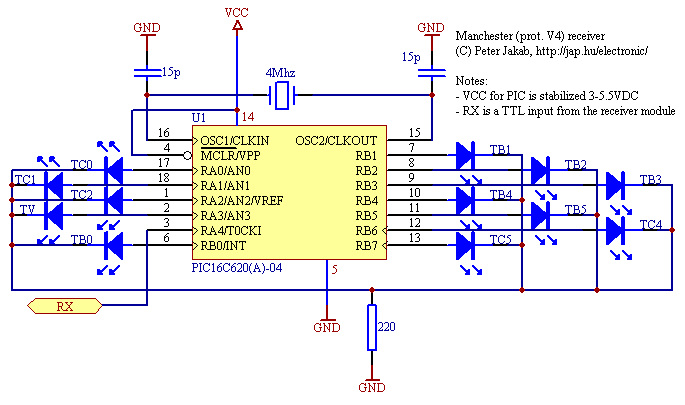
When powered on, in idle mode it emits a 800 Hz synchronization header signal. Otherwise, it will transmit a message like the V2 transmitter described below (tx-002). The hardware is also the same as with the V2 version (without the need for the diodes). Files are mtx-013 and mrx-007.
This one is designed to be a low power transmitter device with one button. It will transmit a message with the number of times the button is pressed. The unused inputs are used to drive a LED and turn on OSC before transmission (it can be used for ASK modulation). You'll have to face the challenge to code the receiver as it is not yet ready. Sorry, no schematic is available for this version. File is mtx-015.
| This code is used to display the receiver code errors and buffers on an LCD display. At least 2x16 line is needed. The LCD library drives a special 3-wire serial interface designed by Myke Predko. File is mrx-008. The LCD interface is described here. | 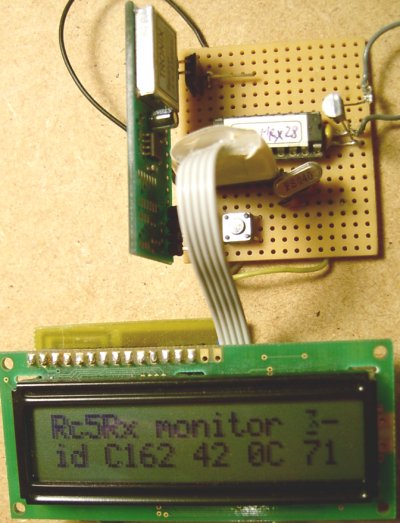 monitoring V4.0 receiver LCD |
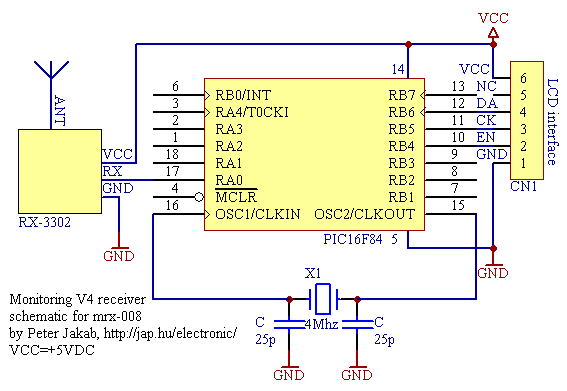
Encoder is a small, low power device which has 5 buttons and
by pressing one or more keys it transmits a message continously.
The transmitted message contains the state of all buttons and it
is sent in each message. On the receiver part, for all
transmitter buttons there exists a corresponding output pin which
will go high for the time the button is being pressed on the
encoder. Files are tx-003 and rx-003. I suggest that you consider
using the newer V4.0 devices or change a few lines to reduce speed
to 400/800 Hz (transmitter delay loop and receiver timer
prescaler).
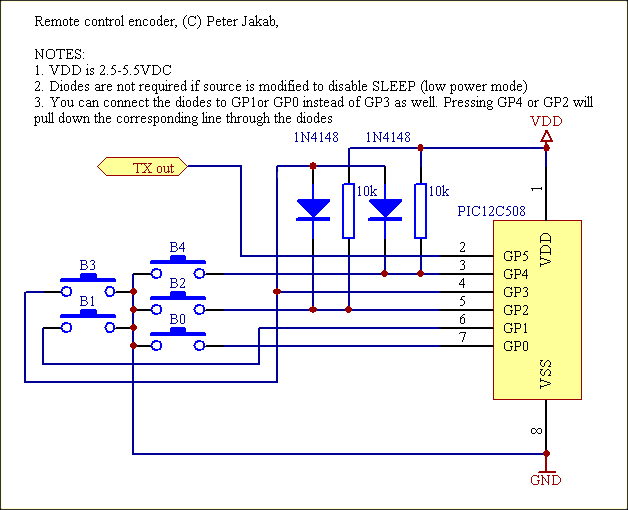
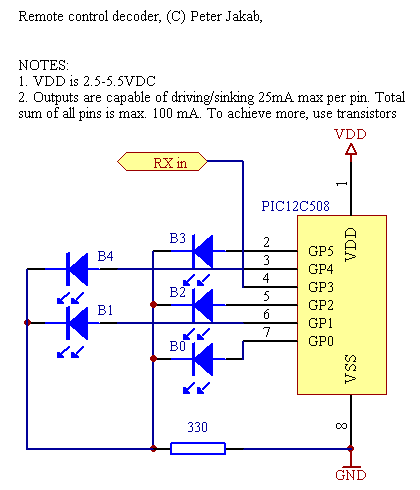 receiver input is GP3. To
reverse the receiver polarity (HIGH on transmitter OFF),
uncomment the define RX1010 in the source. Other pins are
outputs and capable to drive LED diodes or transistors
with relays.
receiver input is GP3. To
reverse the receiver polarity (HIGH on transmitter OFF),
uncomment the define RX1010 in the source. Other pins are
outputs and capable to drive LED diodes or transistors
with relays.| By my own experiences I
realized that one can't easily design & build these
at home. High frequency circuits need special expertise
and equipment so I recommend that you buy a working PCB
module. I used the following devices: HX1000 transmitter
(operates on 3.0-5.5VDC), RX1010 receiver (max. 3VDC)
from RFM and small
ready-made PCB panels: a receiver operating on 5VDC (RX3302)
and a transmitter (9VDC). The PCB transmitter had a 300
usec wake-up which was too much at 1600 Hz with the V3
protocol. The RF modules are available from a lots of
companies. Here is a list of companies from Oricom: Laipac, Linx,
IMST,
Glolab,
Semelab,
Sage, Axonn, Lincast,
Abacom, Ramsey, Orbit, Innomedia,
RF Innovations,
Radiometrix,
QKWElec,
Temic,
Lemos, Unilink,
TrueBlue,
Parallax,
Computronics,
VideoComm,
Rentron
(schematics), RFM |
|
 434M RF modules: RF-EZ STM transmitter, TM01DS transmitter, 15-980TX transmitter |
 434M RF modules: Tronix RX-3302 receiver, Telecontrolli RR8-434 (max 3.3VDC!) receiver |
If you don't have access to ready-made RF modules or want to build an infra version, please check my infrared circuits page. You can easily build these modules yourself.
I developed these programs on the PIC16f84 or PIC16f628 and when everything worked OK, I rewrote the programs for the OTP 12c508, 16c505, 16f620a devices. Use these files at your own risk (especially the compiled HEX binaries), please note that they are provided without any warranty.
| description | transmitter code | TX device | receiver code | RX device | default ID |
| 11-channel V4.0 transmitter and receiver | mtx-014 HEX |
16c505 | mrx-009 HEX |
16c620a | 9ae9 |
| 5-channel V4.0 transmitter and receiver | mtx-013 HEX |
12c508 | mrx-007 HEX |
12c508 | 9ae6 |
| one-button V4.0 transmitter | mtx-015 | 12c508 | c14e | ||
| monitoring V4.0 receiver | mrx-008 | 16f84 | 9ae9 | ||
| experimental pin-selectable address V4.0 receiver | mrx-009b |
16c620a | 9ae9 | ||
| five-button V2 transmitter and receiver (old) | tx-003 HEX |
12c508 | rx-003 HEX |
12c508 | c1062864f14e |
| version | bit0 encoding | bit1 encoding | error codes |
| v2 | 1600 Hz (312 us H, 312 us L) |
800 Hz (625 us H, 625 us L) |
0 = OK 1 = error receiving byte 2 = timeout 3 = checksum error 4 = devid mismatch |
| v3 | 800 Hz (625 us H, 625 us L) |
400 Hz (1250 us H, 1250 us L) |
|
| v4.0 | 800 Hz (625 us H, 625 us L) |
800 Hz (625 us L, 625 us H) |
0 = OK 1 = illegal startbit 2 = signal too long 3 = signal too short 4 = no mid-frame transition/out of sync 7 = byte-ending bit1 missing 8 = byte-ending bit0 missing 9 = header too long 10 = header too short 12 = checksum error 13 = devid mismatch |
Q: How to compile the sources for FLASH parts?
A: Delete and modify lines according to this table.
| delete lines | modify lines |
| #define C505 #define C508 |
;define F84 to #define F84 |
| #define C620 | ;define F628 to #define F628 |
Additionally, the lines translating I/O pins to buffer data may need modifications to make use of the maximum number of available pins, because FLASH parts have a different count of I/O pins.
Q: How to make V4.0 sources go faster?
A: By default, V4.0 sources use a 625 usec half frame delay, this means that your channel must be able to transmit 400-800 Hz frequencies. If you go higher, channel requirements also get stiffer. The lines containing the timing information are:
| meaning | line | example modification |
| transmitter code half frame delay (625 usec) | delayconst EQU .202 |
delayconst EQU .20 |
| receiver code frame
tolerances (min half frame, max half frame+min one frame, max one frame) |
min_t EQU .34 min_2t EQU .104 max_2t EQU .174 |
min_t EQU .3 min_2t EQU .10 max_2t EQU .17 |
By adjusting these values linearly, you can make the code go at your desired rate, slower or faster. Examples show a ten times faster modification. If you want a simpler way or a further speed-up, you can use a faster clock instead of the default 4MHz. But you pay for the clock speedup with two pins on the transmitters, because you can get a different clock rate with an external xtal connected to the PIC.
Q: How do I compile the V4.0 receiver sources?
A: You need to use a linked project in MPLAB. Please check the FAQ at the PIC page.